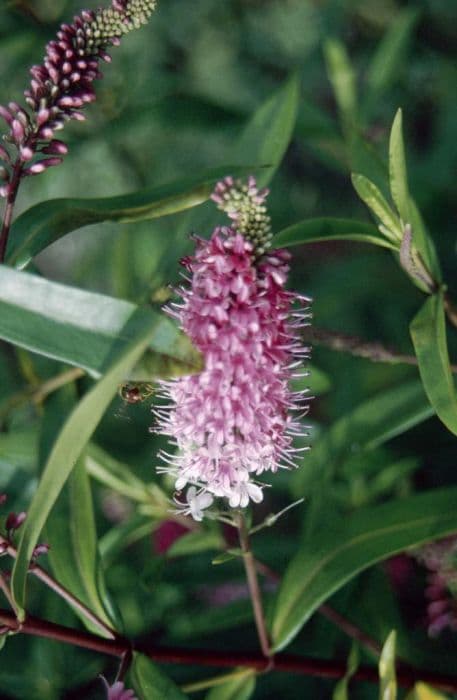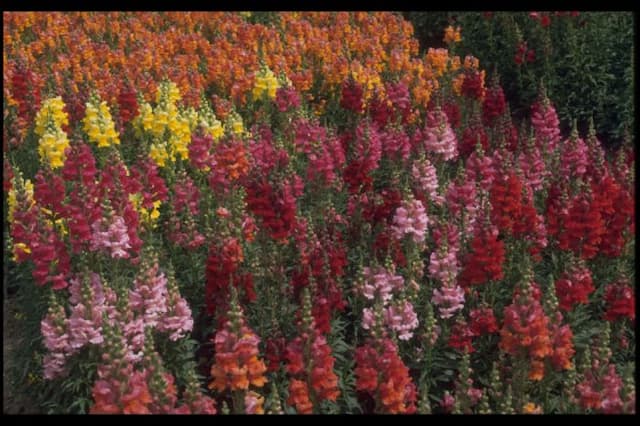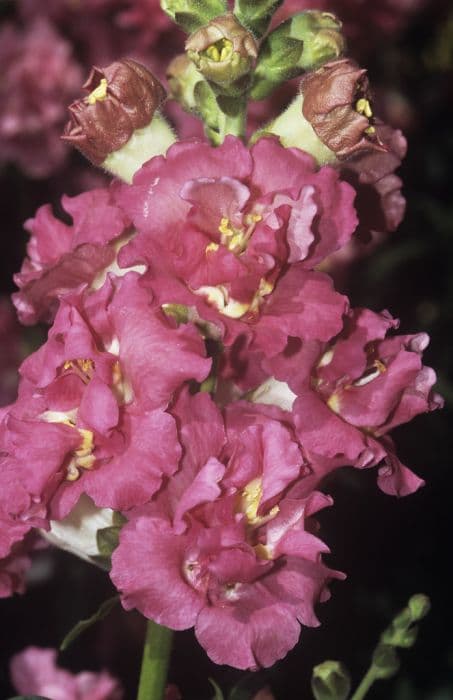Great Orme Hebe Hebe 'Great Orme'

ABOUT
Hebe 'Great Orme' is known for its appealing evergreen foliage and attractive flowers. The plant features glossy, lance-shaped leaves that create a dense, lush mound of greenery. The leaves themselves are quite thick and fleshy, encapsulating a deep green hue that remains vibrant throughout the year. One of the most striking characteristics of Hebe 'Great Orme' is its blooming habit. It boasts spires of flowers that rise above the foliage in a delicate but profuse display. These flowers are typically a rich shade of pink, fading to white at the bases, which adds a soft but noticeable contrast against the darker leaves. As the plant blooms, the flower spikes can become quite heavy and laden with the small, tubular flowers that are clustered tightly together. The overall form of Hebe 'Great Orme' is rounded and bushy, making it a popular choice for adding structure and interest to garden beds and borders. Its robust nature ensures that it maintains a striking presence, with the dense leaves and abundant blooms luring the eyes of passersby. The attractive floral display is not only pleasing to look at but also serves to attract various pollinators, including bees and butterflies, which adds a dynamic and interactive element to its presence in the garden.
About this plant
 Names
NamesSynonyms
Great Orme Hebe, Shrubby Veronica.
Common names
Hebe 'Great Orme'.
 Toxicity
ToxicityTo humans
The Great Orme hebe is generally considered non-toxic to humans. There have been no significant reports of poisoning or toxic reactions from handling or ingesting this plant. However, it is always advised to be cautious with any plant consumption, especially if you are sensitive or have allergies.
To pets
The Great Orme hebe is also generally considered non-toxic to pets. It is not known to cause adverse reactions in pets such as dogs and cats if they ingest small quantities. Nonetheless, ingestion of any plant material may still cause mild gastrointestinal upset in some animals, so it is recommended to keep an eye on your pet and consult a veterinarian if you notice any unusual symptoms.
 Characteristics
CharacteristicsLife cycle
Perennials
Foliage type
Evergreen
Color of leaves
Green
Flower color
Pink
Height
3 feet (0.91 meters)
Spread
3 feet (0.91 meters)
Plant type
Shrub
Hardiness zones
7
Native area
New Zealand
Benefits
 General Benefits
General Benefits- Attractive Foliage: Hebe 'Great Orme' has glossy, green leaves that add texture and year-round interest to gardens.
- Floral Display: It produces abundant spikes of pink to lavender flowers that bloom from summer into fall, providing a long-lasting and vibrant display.
- Wildlife Habitat: The flowers attract butterflies, bees, and other beneficial pollinators, supporting local biodiversity.
- Low Maintenance: Hebe 'Great Orme' is known for being relatively easy to care for, requiring minimal pruning and being resistant to many pests and diseases.
- Drought Tolerant: Once established, it is quite drought tolerant, making it suitable for gardens in drier climates or for water-wise landscaping.
- Versatility: This plant can be used in a variety of settings including borders, containers, rock gardens, and as informal hedging, offering flexibility in garden design.
- Evergreen: As an evergreen shrub, it provides structure and color in the garden throughout the year, even in the winter months.
 Medical Properties
Medical PropertiesThis plant is not used for medical purposes.
 Air-purifying Qualities
Air-purifying QualitiesThis plant is not specifically known for air purifying qualities.
 Other Uses
Other Uses- Source of nectar for bees: Hebe 'Great Orme' is a good source of nectar for bees, making it beneficial for supporting local bee populations and encouraging pollination in the garden.
- Butterfly attractant: The flowers of Hebe 'Great Orme' attract butterflies, adding a dimension of wildlife interest to your garden space.
- Windbreak in coastal areas: Due to its hearty nature, Hebe 'Great Orme' can be used to provide a windbreak in coastal gardens where wind erosion is a problem.
- Erosion control: This plant's dense growth habit can help stabilize soil on slopes or banks, reducing the risk of erosion.
- Natural dye: Some Hebe species have been known to be used for creating natural dyes, although experimentation might be required to use 'Great Orme' for this purpose.
- Garden art: With its unique form and foliage, Hebe 'Great Orme' may be used in topiary or as part of creative garden art installations.
- Hedge or border planting: The dense and evergreen nature of Hebe 'Great Orme' make it suitable for use as a decorative hedge or border in landscaped areas.
- Crafting: The woody stems of mature Hebe 'Great Orme' plants can be used for crafting small items or as decorative elements in floral arrangements.
- Educational tool: Gardeners and educators can use Hebe 'Great Orme' to teach about plant growth, propagation, and the importance of native flora in supporting biodiversity.
- Photography subject: With its picturesque blooms, Hebe 'Great Orme' can be a beautiful subject matter for nature and garden photographers.
Interesting Facts
 Feng Shui
Feng ShuiThe Hebe is not used in Feng Shui practice.
 Zodiac Sign Compitability
Zodiac Sign CompitabilityThe Hebe is not used in astrology practice.
 Plant Symbolism
Plant Symbolism- Eternal Youth: The genus Hebe is named after the Greek goddess of youth, and thus the plant symbolizes everlasting youth and new beginnings.
- Resilience: Hebe plants are known for their hardiness and ability to withstand challenging conditions, symbolizing resilience and adaptability.
- Protection: Some cultures believe that Hebe plants impart protection, perhaps due to their robust nature, providing a sense of safety and shelter.
- Unity: The dense foliage of the Hebe and its habit of growing closely together is often seen as a symbol of unity and togetherness.
- Rejuvenation: With its evergreen leaves and frequent flowering, the Hebe can symbolize rejuvenation, health, and vitality.
 Water
WaterThe Hebe 'Great Orme', commonly known as Shrubby Veronica, prefers to be watered thoroughly, allowing the soil to become moderately dry between watering sessions. In general, watering deeply once a week with about one to two gallons of water should be sufficient, depending on the weather and soil drainage. During hot, dry spells, you might need to water twice a week, whereas in cooler or rainy periods, once every two weeks may suffice. It's essential to avoid waterlogging as this plant does not like to sit in wet soil. A good rule of thumb is to check the top inch of the soil; if it's dry, it's time to water.
 Light
LightShrubby Veronica thrives in full sun to part shade conditions. Ideally, place the plant in a location where it can receive at least six hours of sunlight daily. Although the plant can tolerate some light shade, too little light can lead to spindly growth and fewer flowers. The perfect spot would be one that gets morning sun and some afternoon shade, especially in regions with very hot summers, to protect it from the most intense sun rays.
 Temperature
TemperatureShrubby Veronica can tolerate a wide range of temperatures but thrives in conditions between 50 and 75 degrees Fahrenheit. They are hardy and can withstand temperatures as low as 20 degrees Fahrenheit, making them suitable for many climates. For optimal growth, avoid exposing these plants to prolonged periods of temperatures above 80 degrees Fahrenheit, as this can stress the plant.
 Pruning
PruningPruning Shrubby Veronica is important to maintain its shape, encourage bushier growth, and potentially improve blooming. Deadheading spent flowers can promote a second bloom. Prune in the early spring by cutting back the previous year's growth by about a third. This is also the time to remove any dead or damaged stems. Light pruning can also be done after the plant has flowered to maintain its shape and size.
 Cleaning
CleaningAs needed
 Soil
SoilThe best soil mix for the Hebe 'Great Orme' is a well-drained, loamy soil that has some organic matter mixed in. The soil pH should be slightly acidic to neutral, ranging from 6.0 to 7.0 for optimal growth.
 Repotting
RepottingHebe 'Great Orme' typically doesn't need to be repotted frequently; doing it every 2 to 3 years is sufficient. It's best to repot in the spring, just before the growing season begins, if the plant has outgrown its current pot or the soil has degraded.
 Humidity & Misting
Humidity & MistingHebe 'Great Orme' prefers moderate humidity levels, and it's adaptable to the humidity found in most outdoor environments. There is no need to artificially alter humidity levels for this plant when grown outdoors.
 Suitable locations
Suitable locationsIndoor
Place in bright, indirect light and ensure good air circulation.
Outdoor
Plant in well-drained soil, full sun to partial shade.
Hardiness zone
7-10 USDA
 Life cycle
Life cycleThe life cycle of the Hebe 'Great Orme' begins with seed germination, where the seeds require well-drained soil and light for successful sprouting. Following germination, the seedling stage involves establishing roots and producing its first set of true leaves. As the plant enters the vegetative stage, it develops a robust foliage structure and a sturdy stem, continuously growing until it reaches maturity. The flowering phase comes next, typically in the summer months, when the Hebe 'Great Orme' produces its characteristic spikes of pinkish-purple flowers, attracting pollinators. After pollination, the plant sets seed, which can be dispersed to propagate new plants, completing the reproductive cycle. Finally, in the senescence stage, the plant's growth slows down, and it may die back, especially in colder climates, but under the right conditions, it may persist and regrow for many seasons.
 Propogation
PropogationPropogation time
Spring-Early Summer
Propogation: Hebe 'Great Orme', typically propagated in the spring or early summer, is best multiplied through semi-hardwood cuttings. To do this, select healthy stems that aren't flowering and cut a 4 to 6-inch (10 to 15 cm) length, making sure there are several leaves. Dip the cut end into rooting hormone powder to encourage root growth and plant the cutting into a pot filled with a mix of peat and perlite or a similar well-draining propagation medium. The pot should then be placed in a warm, well-lit area but out of direct sunlight, and the medium should be kept moist but not soggy. Roots usually develop within a few weeks, after which the young Hebe can be gradually acclimatized to outdoor conditions before being planted out.





![Snapdragon [Pretty in Pink]](/_next/image?url=https%3A%2F%2Fplants-admin.emdemapps.com%2Fimages%2Fplants%2F%2Fimages%2F604b5cb3b5385.png&w=640&q=75)



